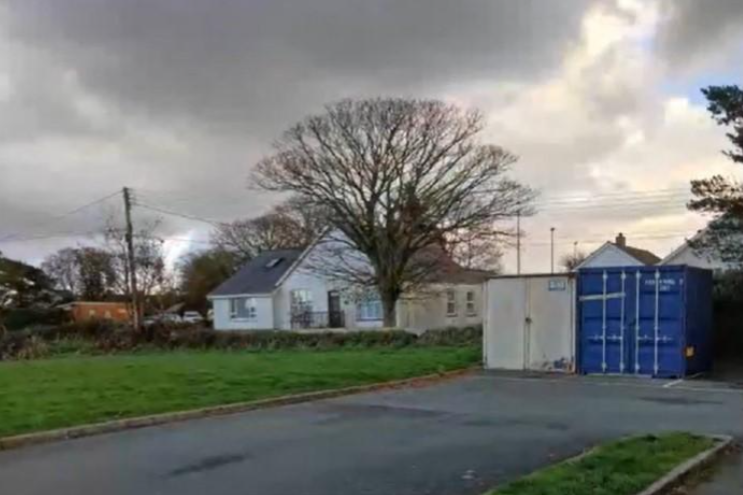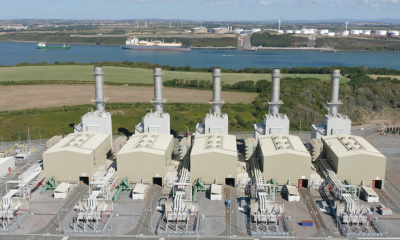Climate
West Wales health board to cut its energy bill by £100,000 per year

HYWEL DDA Health board has launched an innovative, yet simple ‘Switch it off’ campaign to help drastically reduce both its energy usage and costs.
The campaign consists of ‘switching off’ all non-essential equipment when not in use; from computer monitors and laptops to medical equipment, lights, and radiators. This is one of the several initiatives being delivered as part of Hywel Dda’s Decarbonisation Delivery Plan. All of which are aimed at helping to reduce energy costs and CO2 emissions for non-essential equipment by around 20%, which could save around £100,000 per year.
From March 2022 to April 2023, the health board reported spending almost £14 million on energy, producing more than 20 million kg in CO2 emissions. It was evident action needed to be taken to meet its targets to reduce emissions to just 34% by 2030 as set out in the NHS Wales Decarbonisation Strategic Delivery Plan.
Sarah Thorne, Senior One Health Practitioner at Hywel Dda, who has been leading on the implementation of the campaign said: “The ‘Switch-it-off’ campaign is something we expect everyone across the health board and hospital to get involved in. If we all work together, we will see those changes immediately.
“While analysing our energy usage, we discovered that leaving just one TV or PC monitor on standby, instead of switching it off, can waste almost £25 of electricity per year. We have over 6000 screens across the hospital and offices within the health board so if everyone switched off their screen when they weren’t using it, it could help to save a huge amount of money, while also reducing CO2 emissions. It is simple actions like this that will have a massive impact.”
As well as launching the ‘Switch it off’ campaign, the health board has benefitted from Estates Funding Advisory Board (EFAB) funding and Salix funding to support the delivery of a range of decarbonisation projects such as roof mounted Photovoltaics (PV), heat pumps, and solar canopies. It has also made a start in switching its lightbulbs to LED energy saving ones and is planning to install light sensors in communal areas such as toilets and kitchens. Earlier this year, the health board also received funding to install its own solar farm which provides sustainable electricity to power some services, reducing carbon emissions and promoting biodiversity in the area.
Julie James, Minister for Climate Change said: “The ‘Switch it off’ campaign from Hywel Dda is a great example of how organisations can inspire and empower their staff to work together to reduce both carbon emissions, energy usage, costs, and our impact on the environment.
“If everyone could do their bit by ‘switching off’ unnecessarily appliances, it would make a huge difference to the amount of energy we use, which will in turn help us to create a cleaner, greener Wales.”
The Welsh Government has committed to taking action on climate change. Since 2019, the Welsh Government has helped people access greener energy choices. Investing £120million in energy efficiency improvements to social housing through the Optimised Retrofit programme, helping around 148,000 people to live in homes that are cheaper and more efficient to run. The Nest scheme has supported tens of thousands of people to improve the energy efficiency of their home, while in turn reducing energy bills and improving health and wellbeing.
The Welsh Government has also backed flagships schemes such as Ripple Energy’s Wind turbine cooperative, Morriston Hospital’s solar farm and Pobl’s Penderi shared energy initiative, which has seen a community generate and share its own renewable energy. Pilots like these pave the way for similar projects in the future, enabling more people to save money on their energy.
For more advice on how you can reduce your energy use visit climateaction.gov.wales
Climate
Fishguard ‘battery box’ scheme near school refused

PLANNERS have refused a Pembrokeshire ‘battery box’ electricity storage unit near a Pembrokeshire town school, which has seen local objections including fears of a potential risk to nearby school children.
In an application recommended for approval at the December meeting of Pembrokeshire County Council’s planning committee, AMP Clean Energy sought permission for a micro energy storage project on land at Fishguard Leisure Centre Car Park, near Ysgol Bro Gwaun.
The application had previously been recommended for approval at the November meeting, but a decision was deferred pending a site visit.
The scheme is one of a number of similar applications by AMP, either registered or approved under delegated planning powers by officers.
The battery boxes import electricity from the local electricity network when demand for electricity is low or when there are high levels of renewable energy available, exporting it back during periods of high demand to help address grid reliability issues; each giving the potential to power 200 homes for four hours.
The Fishguard scheme, which has seen objections from the town council and members of the public, was before committee at the request of the local member, Cllr Pat Davies.
Fishguard and Goodwick Town Council objected to the proposal on grounds including visual impact, and the location being near the school.
An officer report said the scheme would be well screened by a Paladin Fence, with a need to be sited close to an existing substation.
Speaking at the December meeting, Ben Wallace of AMP Clean Energy conceded the boxes were “not things of beauty” before addressing previously raised concerns of any potential fire risk, saying that “in the incredibly unlikely” event of a fire, the system would contain it for up to two hours, giving “plenty of time” for it to be extinguished, an alarm immediately sounding, with the fire service raising no concerns.
“These are fundamentally safe, the technology is not new,” he said, comparing them to such batteries in phones and laptops.
One of the three objectors at the meeting raised concerns of the proximity to homes and the school, describing it as “an unsafe, unsustainable and unnecessary location,” with Cllr Jim Morgan of Fishguard Town Council, who had previously raised concerns of the “nightmare scenario” of a fire as children were leaving the school, also voicing similar issues.
Local county councillor Pat Davies, who had spoken at the previous meeting stressing she was not against the technology, just the location and the potential risk to pupils, said the siting would be “a visual intrusion,” with the school having many concerns about the scheme, adding it had been “brought forward without any dialogue of consultation with the school”.
Cllr Davies added: “It is unacceptable that a micro-storage unit should be proposed in this area; someone somewhere has got it wrong.”
Following a lengthy debate, committee chair Cllr Mark Carter proposed going against officers in refusing the scheme; members unanimously refusing the application.
Climate
Fears Sageston wind turbine scheme could affect bats

AN APPLICATION for a wind turbine nearly 250 foot high on the road to Tenby, recommended to be turned down due to a lack of information on how it could affect bats, has been put on hold.
In an application recommended for refusal at the December meeting of Pembrokeshire County Council’s planning committee, Constantine Wind Energy Ltd sought permission for a 76-metre-high wind turbine at Summerton Farm, Sageston.
Back in 2024, an application to replace a current 60.5m high turbine on the site with one up to 90 metres, or just under 300 foot, at the site was refused on the grounds its height and scale would have a detrimental impact on the visual amenity of the locality, with the additional clause of failing to comply with supplementary guidance.
A report for committee members on the latest application says the smaller turbine than previously proposed, representing a 16-metre increase in height from a previously granted turbine “would not be sufficient for it to become an overbearing feature in the landscape,” with no objections from either the Council Landscape Officer or Natural Resources Wales.
However, concerns were raised by the council ecologist that the applicant’s Preliminary Ecological Appraisal Report was incomplete.
“The Council Ecologist questions why the response received in relation to myotis bat records were not included within the initial PEA. As such, he considers that the PEA does not present enough information on the possible presence of bats within the application site area.
“Whilst there may be negligible foraging and commuting potential, there are records of foraging on grassland within two kilometres which have positive identification of myotis bat foraging, along with greater and lesser horseshoe bat foraging. He also notes that the application site is in close proximity to a wooded area.”
It was recommended for refusal on the grounds that appraisal report, and technical note, “do not adequately address the impact of the proposed wind turbine on bat activity in the area”.
At the committee meeting, members heard the scheme had been temporarily withdrawn to deal with issues raised, the application expected to return to a future meeting.
Business
Pembrokeshire’s Puffin Produce a winner at British Potato Awards 2025

PEMBROKEHIRE-BASED Puffin Produce, Wales’ leading supplier of fresh root vegetables, has been named winner of the Best Environmental/Sustainability Initiative at the prestigious British Potato Awards 2025.
The judges recognised the company’s whole-system approach that combines ambitious long-term targets with practical, measurable action across its grower network and operations.
A sector-leading grower scheme Launched in winter 2024, the ‘Sustainable Spuds’ programme is already regarded as one of the most progressive grower incentive frameworks in UK agriculture. It rewards farmers with premium payments for verifiable improvements in nutrient efficiency, energy use, soil health, biodiversity and emissions reduction. Covering the entire crop cycle, the scheme is designed to drive rapid on-farm change while remaining commercially viable.
ROOT ZERO – the UK’s first carbon-neutral certified potato Since its 2021 launch, the ROOT ZERO brand has targeted a 51% reduction in carbon intensity per kilo by 2030. Progress is ahead of schedule. The potatoes are packed in 100% plastic-free, compostable and recyclable packaging, while 0.5p from every pack sold is donated to the Bumblebee Conservation Trust. Consumer-facing campaigns also promote low-energy cooking and food-waste reduction.
Verified science-based targets and rapid decarbonisation
Through the Science Based Targets initiative (SBTi), Puffin Produce has committed to cutting Scope 1 & 2 emissions by 46% by 2030 and achieving at least a 90% reduction across all scopes by 2040. Since baseline measurements in 2019:
- Operational emissions are already down 30%
- 2 MW of rooftop solar panels (covering 6,000 m²) now generate 100% of summer electricity demand, saving 2.4 tonnes of CO₂e daily
- Winter power is purchased from guaranteed zero-carbon sources
- Transition away from fossil fuels continues at pace
Zero waste ambition delivered early
Puffin signed the Courtauld 2030 pledge in 2015 to halve food waste by 2030. The company exceeded that target five years early, achieving a 57% reduction despite growing production volumes. Rigorous crop utilisation and technology investments ensure almost every potato grown reaches a plate.
As a Leading Food Partner for FareShare Cymru, Puffin has now helped provide the equivalent of two million meals through its ‘Surplus with Purpose’ programme.
Landscape-scale collaboration In 2025 Puffin co-founded the Wales Landscape Enterprise Network (LENs) – a farmer-led, business-backed model for stacking private and public funding to deliver nature-based solutions. Early results from the first LENs projects in potato-growing catchments are striking:
- 150+ acres of habitat and soil-health enhancements
- 25% average increase in five key wildlife indicator species
- 17% lower carbon emissions per tonne of potatoes
- 40 kg less nitrogen fertiliser per hectare – with no yield penalty
Emma Adams, Head of Sustainability at Puffin Produce, commented: “This award belongs to everyone in our supply chain – growers, team members and partners – who have turned ambition into action. Agriculture is complex, but it is also one of the most powerful tools we have to tackle the climate and nature crises. By working collaboratively and investing boldly, we’re proving that rapid, measurable progress is possible.”
Rooted in Pembrokeshire and sourcing ~80% of its produce from within 50 miles, Puffin Produce remains the only BRC AA+ accredited vegetable packing facility in Wales. It is the proud home of two Protected Geographical Indication (PGI) products – Pembrokeshire Early Potatoes and Welsh Leeks – and supplies major UK retailers and wholesalers all year round.
A standout example of Welsh food production leading the way to net zero and nature recovery.
Photo:
Emma Adams head of sustainability at Puffin Produce receiving the BP Award presented by Adrian Cunnington (L) and Jamie-Sutherland
-

 Crime5 days ago
Crime5 days agoMan denies causing baby’s injuries as police interviews read to jury
-

 Crime1 day ago
Crime1 day agoDefendant denies using Sudocrem-covered finger to assault two-month-old baby
-

 Crime6 days ago
Crime6 days agoMan denies injuring baby as jury hears police interview in ongoing abuse trial
-

 Crime10 hours ago
Crime10 hours agoPembroke rape investigation dropped – one suspect now facing deportation
-

 News10 hours ago
News10 hours agoBaby C trial: Mother breaks down in tears in the witness box
-

 Crime6 days ago
Crime6 days agoMilford Haven man jailed after online paedophile sting
-

 Crime2 days ago
Crime2 days agoDefendant denies causing injuries to two-month-old baby
-

 Crime1 day ago
Crime1 day agoLifeboat crew member forced to stand down after being assaulted at Milford pub





















